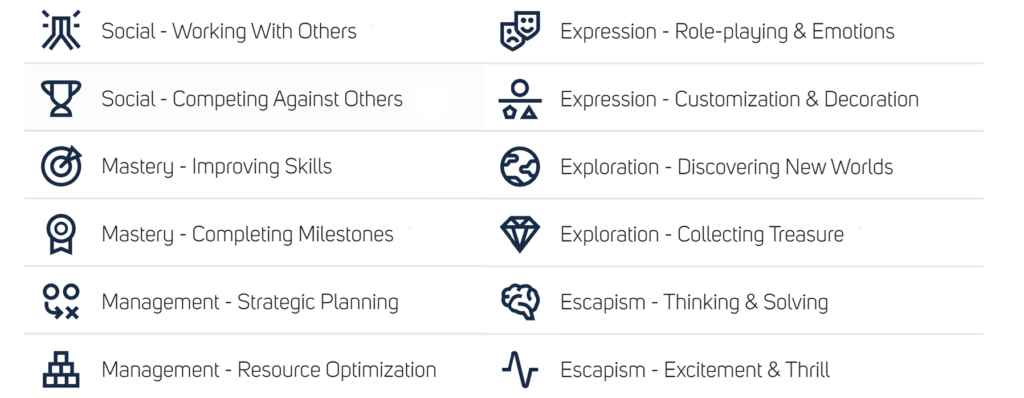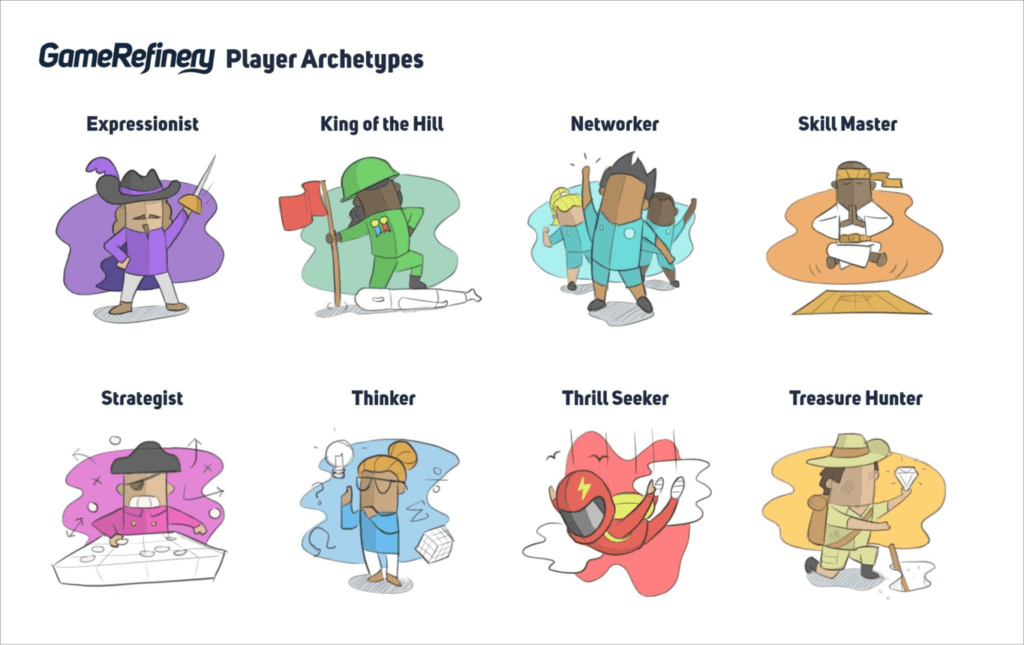
Understanding Gamification, Player Motivations, and Their Impact on Mobile UA
The recipe for a successful marketing strategy usually goes like this: Identify your target audience, understand what makes them tick, and know how to keep them engaged.
The video game industry has had a lot of practice at such an exercise — multiple decades, in fact — which is one of the reasons why so many non-gaming apps, from fitness and fintech to productivity and personal development, use gamification to drive user acquisition and engagement.
For app marketers, the elements of gamification you incorporate into your mobile apps and even UA campaigns through playable ads should be guided by audience data. In short, effective gamification means knowing which elements will motivate your users the most.
In this blog post, we’ll guide you through:
- Understanding gamification
- The GameRefinery Motivational Driver Framework
- How to use this framework to understand what motives your users
- Categorizing your users using GameRefinery’s Player Archetypes
- Examples of effective gamification in practice
What is gamification?
In the app world, gamification is where features and principles from game design are incorporated into the app experience. This might include progressive milestones where users can track their progress by gaining experience, a leveling or trophy system where users earn rewards for progression, or leaderboards where users compare their progress against other app users.
You’ll find a lot of gamification elements in mobile apps because they work. Humans have been ‘playing’ for thousands of years, so the traits we associate with playing games, such as socializing, cognitive thinking, and competition, are inherent to human behavior. When app marketers understand these traits and how to tap into them using gamification, it can bring in new users and increase engagement time.
Some of the benefits of gamification in mobile apps include:
- Increased user engagement and lower churn rate by encouraging users to complete and follow through with specific tasks.
- Better retention rates as users are encouraged to make consistent progress and dislike abandoning tasks.
- Better visibility for your app if your gamification elements encourage users to share their progress on social media.
- Increased enjoyment and user satisfaction by appealing to the specific motivations of players, such as incorporating player-versus-player or cooperative elements for users who are stimulated by socializing with others.
You’ll need to understand what your users are motivated by to make the most of these benefits. The type of games that people engage with depends on their personal preferences. Some people are drawn to games because they enjoy competition, while others enjoy the cognitive challenges of puzzle games.
This is where the GameRefinery Motivational Driver Framework comes into play.
Understanding player motivations

Understanding your users’ specific needs and wants isn’t easy, but GameRefinery’s Motivational Driver Framework makes things much easier. Created through extensive survey research coupled with advanced data science and statistical modeling, this model unpacks the specific motivations of players into 12 Motivational Drivers, each covering a separate root player motivation.
These are:
- Social – Working With Others
- Social – Competing Against Others
- Mastery – Improving Skills
- Mastery – Completing Milestones
- Management – Strategic Planning
- Management – Resource Optimization
- Expression – Role Playing & Emotions
- Expression – Customization & Decoration
- Exploration – Discovering New Worlds
- Exploration – Collecting Treasure
- Escapism – Thinking & Solving
- Escapism – Excitement & Thrill
While this framework was created for mobile game developers, it can also help app marketers categorize their users and better understand what motivates them. Combined with the user insights and Player Archetypes information available through the GameRefinery platform, the framework can even help you discover new gamification elements that will appeal to your users. Let’s look at Scopely’s mega-hit, MONOPOLY GO!, as an example.
Don’t forget: GameRefinery’s unique methodology and understanding of audience motivations are also incorporated into Liftoff Intelligence, which offers mobile apps from any vertical tailor-made analyses full of actionable data and insights.
How to use the Motivational Driver Framework

Scopely’s MONOPOLY GO! is one of the most successful mobile games ever released, making $2 billion since its launch under a year ago. While this success can be attributed to extensive R&D, user testing, a well-known IP, supreme UA strategies, and, of course, a great game, we can use the Motivational Driver Framework to see that MONOPOLY GO! takes a slightly different approach to other games in its genre (Casual Casino).
There’s less focus on Customization & Decoration and Discovering New Worlds (already low for the genre) but more on Collecting Treasure and Thinking & Solving. This data shows that MONOPOLY GO! players enjoy Completing Milestones, Competing Against Others, and Collecting Treasure, as the three have a natural alignment.
Pro Tip: If you’re an app marketer already utilizing Milestones in your gamification, you might want to consider showing your app’s Collecting Treasure (done via in-game digital rewards such as medals for completing milestones) or Thinking & Solving (strategic gamification elements such as puzzles and quizzes) elements into your ad creatives.
Categorizing your users using GameRefinery’s player archetypes

If you’re uncertain about which elements of gamification will appeal most to your users, then look no further than GameRefinery’s Player Archetypes. Backed by extensive research and statistical modeling (i.e., statistical clustering methods), these archetypes break down the millions of mobile users on the market into eight succinct categories — each with a set of Motivational Drivers that resonate exceptionally well with them.
Here are the eight current Player Archetypes:
- Expressionists love to show off their personality through gameplay, such as by decorating, designing, role-playing, or even storytelling.
- Kings of the Hill crave intense competition. They get immense satisfaction from outsmarting, outmaneuvering, and outlasting opponents in player-versus-player engagements.
- Networkers see gaming as a social activity that’s best enjoyed with others. They like working with friends (or even random people) to achieve goals.
- Skill Masters want to be the best. They see harder difficulties and steep learning curves as appealing and are happy when others acknowledge their high skill level.
- Strategists are drawn to games that reward (but also require) calculated planning, tactical execution, and meticulous resource optimization.
- Thinkers enjoy playing games for the cognitive challenge. They’re drawn to brain teasers and other puzzles, which help them to take their minds off other things.
- Thrill Seekers want to experience an adrenaline rush rather than waste their time on slow-paced games requiring lots of strategic planning and thinking.
- Treasure Hunters prefer games that constantly offer new areas to explore. They also like to have a wide range of items, characters, and other things to collect.
Like the Motivational Driver Framework, these Player Archetypes were primarily designed to support mobile game developers and marketers. However, applying them to the most popular apps known for gamification shows that they are used in non-gaming apps across the industry, from e-commerce to finance to dating and social. For example, Nike Run Club has a significant number of social share features (Networker), challenges, and leaderboards (Skill Master and King of the Hill), as well as the ability to personalize your workouts and overall experience (Expressionist).
Next, let’s look at one of the most successful examples of gamification by a non-gaming app in practice in the app world.
How Duolingo gamifies learning a new language
There are a lot of different apps out there that can help you learn new languages, but Duolingo stands among the best. In 2021, TechCrunch stated that the app had over 500 million registered users, 40 million active users, 1.5 million premium subscribers, and $190 million in revenue. But besides having a colorful owl as its mascot, what does Duolingo do to keep its users returning?
Duolingo offers more than just cleverly articulated lessons — it uses gamification to help users develop long-term study habits and make learning a new language less a chore and more a game.
For example, one of the primary ways Duolingo uses gamification to drive engagement is what they call “skill levels”. You get a shiny gold skill medal each time you complete a lesson. Duolingo stated that feedback from their users was that they loved to get a whole screen full of gold icons, meaning they had a bunch of Treasure Hunters on their hands.
Duolingo used this to its advantage, developing a way of encouraging users to revise completed lessons and cement their knowledge. Now, after a certain amount of time passes, these gold icons “crack,” ruining a perfect golden wall and lowering the overall completion meter for that specific module. Treasure Hunters hold their collection dearly and are motivated to go back and restore it to its original glory.
Regarding the Motivational Driver Framework, this gamification aspect falls under “Exploration – Collecting Treasure,” which makes sense given that many people who choose to learn another language are likely doing so because they plan to spend time abroad exploring the world.
Summary
While app marketers might think the world of video games is separate from apps, the line is far more blurred than it seems. By tapping into some of the most successful elements of popular video game genres through gamification, such as the community-building nature of multiplayer games or thoughtful progression of RPGs, mobile marketers can enjoy increased engagement, lower churn rates, enhanced visibility, better retention, and more.
To harness gamification’s power, carefully analyze what motivates your user base by taking advantage of GameRefinery’s Motivational Driver Framework and Player Archetypes and translate those insights into compelling features that users can’t resist.